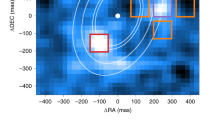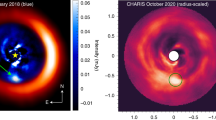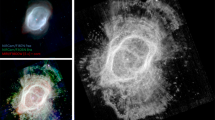Abstract
We still do not understand how planets form or why extrasolar planetary systems are so different from our own Solar System. However, the past few years have dramatically changed our view of the disks of gas and dust around young stars. Observations with the Atacama Large Millimeter/submillimeter Array and extreme adaptive-optics systems have revealed that most—if not all—disks contain substructure, including rings and gaps1,2,3, spirals4,5,6, azimuthal dust concentrations7 and shadows cast by misaligned inner disks5,8. These features have been interpreted as signatures of newborn protoplanets, but the exact origin is unknown. Here we report the kinematic detection of a few-Jupiter-mass planet located in a gas and dust gap at 130 au in the disk surrounding the young star HD 97048. An embedded planet can explain both the disturbed Keplerian flow of the gas, detected in CO lines, and the gap detected in the dust disk at the same radius. While gaps appear to be a common feature in protoplanetary disks2,3, we present a direct correspondence between a planet and a dust gap, indicating that at least some gaps are the result of planet–disk interactions.
This is a preview of subscription content, access via your institution
Access options
Access Nature and 54 other Nature Portfolio journals
Get Nature+, our best-value online-access subscription
$29.99 / 30 days
cancel any time
Subscribe to this journal
Receive 12 digital issues and online access to articles
$119.00 per year
only $9.92 per issue
Buy this article
- Purchase on Springer Link
- Instant access to full article PDF
Prices may be subject to local taxes which are calculated during checkout




Similar content being viewed by others
Data availability
Raw data is publicly available via the ALMA archive under project ID 2016.1.00826.S. Final reduced and calibrated data cubes are available at https://doi.org/10.6084/m9.figshare.8266988.
Code availability
Phantom is publicly available at https://bitbucket.org/danielprice/phantom. mcfost is currently available under request and will be made open-source soon. Figures were generated with splash46 (http://users.monash.edu.au/~dprice/splash/) and pymcfost (https://github.com/cpinte/pymcfost), which are both open source.
References
ALMA Partnership et al. The 2014 ALMA long baseline campaign: first results from high angular resolution observations toward the HL Tau region. Astrophys. J. Lett. 808, L3 (2015).
Long, F. et al. Gaps and rings in an ALMA survey of disks in the Taurus star-forming region. Astrophys. J. 869, 17 (2018).
Huang, J. et al. The disk substructures at high angular resolution project (DSHARP). II. Characteristics of annular substructures. Astrophys. J. Lett. 869, L42 (2018).
Benisty, M. et al. Asymmetric features in the protoplanetary disk MWC 758. Astron. Astrophys. 578, L6 (2015).
Stolker, T. et al. Shadows cast on the transition disk of HD 135344B. Multiwavelength VLT/SPHERE polarimetric differential imaging. Astron. Astrophys. 595, A113 (2016).
Huang, J. et al. The disk substructures at high angular resolution project (DSHARP). III. Spiral structures in the millimeter continuum of the Elias 27, IM Lup, and WaOph 6 disks. Astrophys. J. Lett. 869, L43 (2018).
van der Marel, N. et al. A major asymmetric dust trap in a transition disk. Science 340, 1199–1202 (2013).
Marino, S., Perez, S. & Casassus, S. Shadows cast by a warp in the HD 142527 protoplanetary disk. Astrophys. J. Lett. 798, L44 (2015).
Takahashi, S. Z. & Inutsuka, S.-i Two-component secular gravitational instability in a protoplanetary disk: a possible mechanism for creating ring-like structures. Astrophys. J. 794, 55 (2014).
Gonzalez, J.-F., Laibe, G., Maddison, S. T., Pinte, C. & Ménard, F. ALMA images of discs: are all gaps carved by planets? Mon. Not. R. Astron. Soc. 454, L36–L40 (2015).
Lorén-Aguilar, P. & Bate, M. R. Toroidal vortices and the conglomeration of dust into rings in protoplanetary discs. Mon. Not. R. Astron. Soc. 453, L78–L82 (2015).
Zhang, K., Blake, G. A. & Bergin, E. A. Evidence of fast pebble growth near condensation fronts in the HL Tau protoplanetary disk. Astrophys. J. Lett. 806, L7 (2015).
Béthune, W., Lesur, G. & Ferreira, J. Self-organisation in protoplanetary discs. Global, non-stratified Hall-MHD simulations. Astron. Astrophys. 589, A87 (2016).
Dipierro, G. et al. On planet formation in HL Tau. Mon. Not. R. Astron. Soc. 453, L73–L77 (2015).
Zhang, S. et al. The disk substructures at high angular resolution project (DSHARP). VII. The planet–disk interactions interpretation. Astrophys. J. Lett. 869, L47 (2018).
Rameau, J. et al. An optical/near-infrared investigation of HD 100546 b with the Gemini Planet Imager and MagAO. Astron. J. 153, 244 (2017).
Ligi, R. et al. Investigation of the inner structures around HD 169142 with VLT/SPHERE. Mon. Not. R. Astron. Soc. 473, 1774–1783 (2018).
Currie, T. et al. No clear, direct evidence for multiple protoplanets orbiting LkCa 15: LkCa 15 bcd are likely inner disk signals. Preprint at https://arxiv.org/abs/1905.04322 (2019).
Keppler, M. et al. Discovery of a planetary-mass companion within the gap of the transition disk around PDS 70. Astron. Astrophys. 617, A44 (2018).
Müller, A. et al. Orbital and atmospheric characterization of the planet within the gap of the PDS 70 transition disk. Astron. Astrophys. 617, L2 (2018).
Christiaens, V. et al. Separating extended disc features from the protoplanet in PDS 70 using VLT/SINFONI. Mon. Not. R. Astron. Soc. 486, 5819–5837 (2019).
Haffert, S. Y. et al. Two accreting protoplanets around the young star PDS 70. Nat. Astron. https://doi.org/10.1038/s41550-019-0780-5(2019).
Perez, S. et al. Planet formation signposts: observability of circumplanetary disks via gas kinematics. Astrophys. J. Lett. 811, L5 (2015).
Pinte, C. et al. Kinematic evidence for an embedded protoplanet in a circumstellar disk. Astrophys. J. Lett. 860, L13 (2018).
Teague, R., Bae, J., Bergin, E. A., Birnstiel, T. & Foreman-Mackey, D. A kinematical detection of two embedded Jupiter-mass planets in HD 163296. Astrophys. J. Lett. 860, L12 (2018).
Pinte, C. et al. Direct mapping of the temperature and velocity gradients in discs. Imaging the vertical CO snow line around IM Lupi. Astron. Astrophys. 609, A47 (2018).
Dong, R., Liu, S.-Y. & Fung, J. Observational signatures of planets in protoplanetary disks: planet-induced line broadening in gaps. Astrophys. J. 870, 72 (2019).
Ginski, C. et al. Direct detection of scattered light gaps in the transitional disk around HD 97048 with VLT/SPHERE. Astron. Astrophys. 595, A112 (2016).
Dong, R. & Fung, J. What is the mass of a gap-opening planet? Astrophys. J. 835, 146 (2017).
Rosotti, G. P., Juhasz, A., Booth, R. A. & Clarke, C. J. The minimum mass of detectable planets in protoplanetary discs and the derivation of planetary masses from high-resolution observations. Mon. Not. R. Astron. Soc. 459, 2790–2805 (2016).
Kataoka, A. et al. Submillimeter polarization observation of the protoplanetary disk around HD 142527. Astrophys. J. Lett. 831, L12 (2016).
Dent, W. R. F. et al. Submillimetre dust polarization and opacity in the HD163296 protoplanetary ring system. Mon. Not. R. Astron. Soc. 482, L29–L33 (2019).
Gaia Collaboration et al. Gaia Data Release 2. Summary of the contents and survey properties. Astron. Astrophys. 616, A1 (2018).
Lagage, P.-O. et al. Anatomy of a flaring proto-planetary disk around a young intermediate-mass star. Science 314, 621–623 (2006).
van der Plas, G. et al. Cavity and other radial substructures in the disk around HD 97048. Astron. Astrophys. 597, A32 (2017).
Price, D. J. et al. Phantom: a smoothed particle hydrodynamics and magnetohydrodynamics code for astrophysics. Publ. Astron. Soc. Aust. 35, e031 (2018).
Hutchison, M., Price, D. J. & Laibe, G. MULTIGRAIN: a smoothed particle hydrodynamic algorithm for multiple small dust grains and gas. Mon. Not. R. Astron. Soc. 476, 2186–2198 (2018).
Ballabio, G. et al. Enforcing dust mass conservation in 3D simulations of tightly coupled grains with the PHANTOM SPH code. Mon. Not. R. Astron. Soc. 477, 2766–2771 (2018).
Shakura, N. I. & Sunyaev, R. A. Black holes in binary systems. Observational appearance. Astron. Astrophys. 24, 337–355 (1973).
Lodato, G. & Price, D. J. On the diffusive propagation of warps in thin accretion discs. Mon. Not. R. Astron. Soc. 405, 1212–1226 (2010).
Bate, M. R., Bonnell, I. A. & Price, N. M. Modelling accretion in protobinary systems. Mon. Not. R. Astron. Soc. 277, 362–376 (1995).
Pinte, C., Ménard, F., Duchêne, G. & Bastien, P. Monte Carlo radiative transfer in protoplanetary disks. Astron. Astrophys. 459, 797–804 (2006).
Pinte, C. et al. Benchmark problems for continuum radiative transfer. High optical depths, anisotropic scattering, and polarisation. Astron. Astrophys. 498, 967–980 (2009).
Woitke, P. Consistent dust and gas models for protoplanetary disks III. Models for selected objects from the FP7 DIANA project. Publ. Astron. Soc. Pac. 131, 064301 (2019).
Woitke, P. et al. Consistent dust and gas models for protoplanetary disks. I. Disk shape, dust settling, opacities, and PAHs. Astron. Astrophys. 586, A103 (2016).
Price, D. J. splash: an interactive visualisation tool for smoothed particle hydrodynamics simulations. Publ. Astron. Soc. Aust. 24, 159–173 (2007).
Acknowledgements
C.P., D.J.P. and V.C. acknowledge funding from the Australian Research Council via FT170100040 and DP180104235. F.M., G.v.d.P. and C.P. acknowledge funding from ANR of France (ANR-16-CE31-0013). This work was performed on the OzSTAR national facility at Swinburne University of Technology. OzSTAR is funded by Swinburne and the Australian Government’s Education Investment Fund. This paper makes use of the following ALMA data: ADS/JAO.ALMA#2016.1.00826.S. ALMA is a partnership of ESO (representing its member states), NSF (USA) and NINS (Japan), together with NRC (Canada) and NSC and ASIAA (Taiwan) and KASI (Republic of Korea), in cooperation with the Republic of Chile. The Joint ALMA Observatory is operated by ESO, AUI/NRAO and NAOJ. The National Radio Astronomy Observatory is a facility of the National Science Foundation operated under cooperative agreement by Associated Universities, Inc.
Author information
Authors and Affiliations
Contributions
C.P. analysed the data, carried out the modelling and wrote the manuscript. G.v.d.P. wrote the observing proposal and reduced the data. D.J.P. provided advice on running the smoothed particle hydrodynamics simulations and made some of the figures. All co-authors provided input on the manuscript.
Corresponding author
Ethics declarations
Competing interests
The authors declare no competing interests.
Additional information
Peer review information: Nature Astronomy thanks Richard Teague and the other, anonymous, reviewer(s) for their contribution to the peer review of this work.
Publisher’s note: Springer Nature remains neutral with regard to jurisdictional claims in published maps and institutional affiliations.
Supplementary information
Supplementary Information
Supplementary Figs. 1–8.
Rights and permissions
About this article
Cite this article
Pinte, C., van der Plas, G., Ménard, F. et al. Kinematic detection of a planet carving a gap in a protoplanetary disk. Nat Astron 3, 1109–1114 (2019). https://doi.org/10.1038/s41550-019-0852-6
Received:
Accepted:
Published:
Issue Date:
DOI: https://doi.org/10.1038/s41550-019-0852-6
This article is cited by
-
Herbig Stars
Space Science Reviews (2023)
-
Modeling the arc and ring structures in the HD 143006 disk
Science China Physics, Mechanics & Astronomy (2022)
-
An inherited complex organic molecule reservoir in a warm planet-hosting disk
Nature Astronomy (2021)



